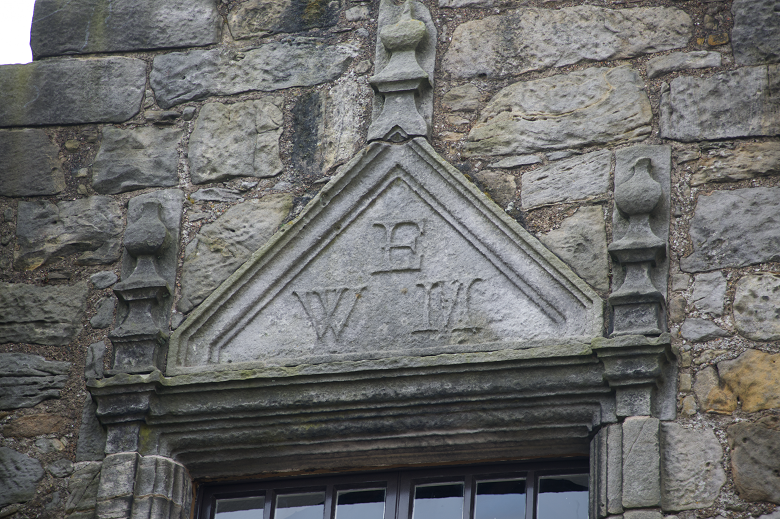Aberdour Castle has witnessed 500 years of noble living. It was as a place of security, before less turbulent times saw it transformed into a sumptuous residence. William Douglas, 8th Earl of Morton, was responsible for many of the changes.
The Earl’s lifestyle inspired the latest in our Historic Channel Hopping series, which sees Historic Scotland sites meet cult TV shows. This time, Morton proudly showed the cameras around his Aberdour crib.
Who was the 8th Earl of Morton?
William Douglas was born in 1582 and became Earl of Morton in on 4 November 1606. We don’t know a huge amount about his early life. There’s even uncertainty about his title, with some referring to him as the 7th Earl of Morton.
It’s likely the confusion of numbering occurred in 1581 when William’s uncle (Lord Maxwell, the 4th Earl) was executed, but then pardoned in 1585. For a period, two different men, one from the Douglas family and one from the Maxwell family, called themselves the 5th Earl of Morton. As such, the early days of Morton’s career were spent dealing with a Morton-Maxwell feud. At it’s peak, it saw both families sent home from parliament in disgrace.

Morton’s initials are proudly displayed on the comfortable east range which he built at Aberdour
However, Morton went on to be a wealthy and respected politician. After a tour of Europe, he was made a privy councillor in 1621, taking responsibility for “the king’s most weyghtie affairis”. Between 1630 and 1636, Douglas served as Lord High Treasurer of Scotland, a highly prestigious post.
Royal rumbles
Morton was an ardent royalist. He was a gentleman of James VI’s bedchamber and, when James died in 1625, Morton bore the royal standard at his funeral. His loyalty to the crown continued into the reign of Charles I. He was part of the organisation committee for the king’s trip to Scotland in 1633 and is said to have been a trusted confidant for when the monarch wished to discuss Scottish matters.

The windows of Morton’s gallery commanded views across the castle’s terraced gardens towards the Firth of Forth
In 1641, Charles nominated Morton for the role of Lord Chancellor of Scotland. Morton turned down the offer in the face of opposition from his son-in-law the Earl of Argyll. Argyll argued that the role would allow Morton to avoid paying off his considerable debts. Five years earlier, Morton had voluntarily left his position as Lord High Treasurer, but only because Charles promised him protection from his creditors.
As might be expected, Morton threw his support behind the crown during the War of the Three Kingdoms. In July 1642 he sold the chief family seat, Dalkeith Palace, to provide £100,000 for the Royalist cause. As a result, Aberdour Castle became his main residence.
Additions at Aberdour

Morton’s gallery was used for work and leisure.
Morton had made Aberdour more lavish and luxurious than at any other point in its history. Most notably he added the east range, which is by far the best-preserved part of the castle today. The initials WEM (for William, Earl of Morton) are elaborately carved into high above one of the entrances.
Inside, the large, lengthy gallery was designed to reflect the power and prestige of the Douglas dynasty. Portraits of the earl’s ancestors would have hung between windows offering spectacular views across the terraced gardens towards Lothian in the distance, where coal mines had made the family fortune.

How a gathering in the gallery at Aberdour might have looked in Morton’s time.
The gallery was multifunctional – a place for banquets, functions, private meetings and exercising, should the Scottish weather prevent use of the grounds. Thanks to an inventory made in 1647, we know about the layout of the castle and how it was furnished. The walls were adorned with tapestries and the private rooms had beds made of red silk, with lace or gold fringes.
Horsing about

The curiously-located stables at Aberdour
One unusual feature of Aberdour which didn’t make it into our film is the stables. Somewhat bizarrely, they are located in the formal area of the castle, directly beneath the gallery. It would be more conventional to keep horses further away from the main castle, but it seems the earl was an enthusiastic equestrian!
Dressage was a popular aristocratic pursuit in the early 1600s. There’s archival evidence that Morton paid for his son Robert to travel to Paris to attend an exclusive riding school. The location of the stables could therefore have been another way for Morton to use Aberdour to show off his prestige.
Final years
Much of Morton’s final years were spent further north. In return for his wartime support, he was given a royal charter, dated 15 June 1643, which granted him rights over Orkney and Shetland. Around the same time, however, Scottish commissioners put his name on a list of “incendiaries between the two kingdoms”.
Evading capture, Morton subsequently used Kirkwall as his base. He died there on 7 August 1648. One of his last recorded acts, on 1 May, was signing an obligation to pay Michael Shaw of Kirkwall £2000.
It seems quite an inglorious ending for one of the richest and most respected men of his age. But Aberdour still stands proud as part of the legacy of the 8th Earl of Morton. Whether or not he’d approve of our tongue-in-cheek video portrayal, it’s impossible to say.
Aberdour Castle is open to visitors throughout the year.

